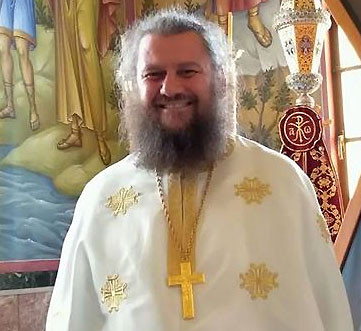St. Andrew the First-Called Orthodox Church is the only church in Bulgaria’s capital and the Sofia eparchy named after this apostle of Christ, priest Stilian Tabakov told Radio Bulgaria.
 The population of Banishora residential district increased significantly in size ad population in a short period of time after the liberation from Ottoman Rule. The local Christians decided to build a church in their residential district. Once, Banishora was among the highest points in Sofia. The local authorities decided to build a big temple on a large plot of land in honor and memory of all Bulgarian volunteers who fought for Bulgaria. This was so, because after the First World War the Bulgarians were very grateful to those who spilled their blood for their motherland. That is why the nearby avenue was named Opalchenska (after the Bulgarian volunteers). The people who settled in this residential district knew well how the Bulgarian volunteers fought for them. That is why the history of Banishora residential district and the St. Andrew the First-Called Orthodox Church are connected with Bulgaria’s history.
The population of Banishora residential district increased significantly in size ad population in a short period of time after the liberation from Ottoman Rule. The local Christians decided to build a church in their residential district. Once, Banishora was among the highest points in Sofia. The local authorities decided to build a big temple on a large plot of land in honor and memory of all Bulgarian volunteers who fought for Bulgaria. This was so, because after the First World War the Bulgarians were very grateful to those who spilled their blood for their motherland. That is why the nearby avenue was named Opalchenska (after the Bulgarian volunteers). The people who settled in this residential district knew well how the Bulgarian volunteers fought for them. That is why the history of Banishora residential district and the St. Andrew the First-Called Orthodox Church are connected with Bulgaria’s history.
In 1925 the Sofia municipality provided a large plot of public land locked between four streets Opalchenska, Strandzha, Kavala and Struma for the construction of the new church with the blessing of the Sofia Metropolitan Stefan I. The local people had an idea to build a massive temple such as the Saint Alexander Nevsky Cathedral. Unfortunately, their idea did not materialize due to the lack of enough financing. The deficit of money in Bulgaria was huge after the Balkan Wars which were detrimental to Bulgaria. As a result, the Bulgarian Orthodox Church built a small chapel instead. It was sanctified in 2016. It was completely destroyed by an aerial bomb during the Bombing of Sofia in the Second World War. Thanks to the huge efforts of Priest Vasilli Popdimitrov the chapel was rebuilt in three years only. When the Bulgarian Patriarchate was restored in 1953 the newly-appointed Bulgarian Patriarch Cyril tried to extend this temple. Two new rear wings and a tall belfry were built with his blessing. The temple was consecrated in 1972 after the construction works. In his speech on occasion of the 50th anniversary of the sanctification of St Andrew Church the Metropolitan Bishop of the Sofia Parthenius called it the fourth cathedral in Sofia together with the Saint Sophia cathedral, Saint Alexander Nevsky Patriarchal Cathedral and St. Nedelya Metropolitan Cathedral.
Of course, the people who go to the church and the parish members make it important, not its size. That is why The St. Andrew the First-Called Orthodox Church has been one of the biggest cleric centers in Bulgaria since it was built. An Orthodox Brotherhood was established at the temple back in 1953. Since then educational lectures are held traditionally each Wednesday at St. Andrew the First-Called church. The head of the temple as well as representatives of the Sofia Theological Seminary and the Bulgarian Ecclesiastical Academy deliver lectures there.
Unfortunately, the church was built over an unstable terrain and the belfry is about to collapse, priest Stilian says and adds;
We have already made geodesic studies and know where exactly the foundations of the new belfry should be laid. We also made plans how to rebuild the belfry. Thus, we would save the temple and prevent possible fatal accidents in the future.
A donation box was placed inside the temple named after the First-Called Apostle of Christ. Those who are grateful to the Bulgarian volunteers who died for the liberation of this country can go to the church and donate money. It will be used for the restoration of the church belfry. Hopefully one day the donated money will be enough to fulfill the dream of our ancestors to build an imposing temple there.
English version: Kostadin Atanasov
Photos: dveri.bg и pravoslavie.bg
On the third day of Christmas, December 27, the Bulgarian Orthodox Church commemorates the memory of Saint Stephen, the first Christian martyr. His name means "crown" or "wreath" and comes from the Greek "στέφανος" (stéphanos). It symbolizes victory..
At sunset on December 25, the Jewish community begins to celebrate Hanukkah. The holiday begins on the 25th day of the Jewish month of Kislev in the Hebrew calendar and, depending on the year, can fall in November or December. By lighting 9..
The Bulgarian Orthodox Church celebrates Christmas with solemn services. The festive services began on Christmas Eve, when the church held a solemn vigil. Hundreds of laypeople gathered at the St. Alexander Nevsky Cathedral in Sofia, where..
Every year on February 10, the feast of St. Haralambos , Bishop of Magnesia, is celebrated with special solemnity in a small Bulgarian town in the..

+359 2 9336 661
